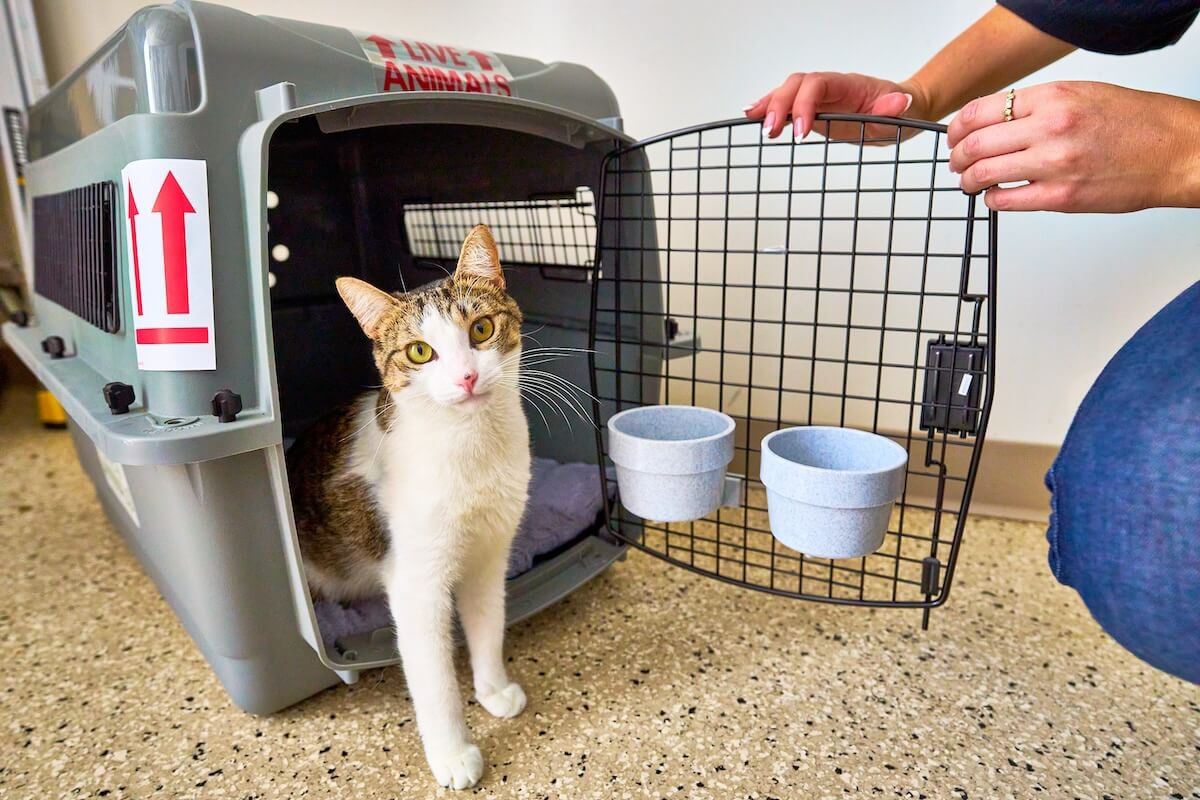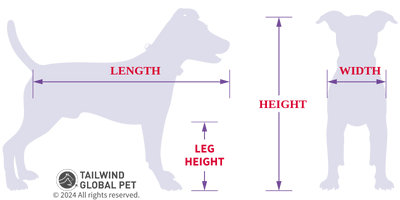How to Choose the Right Pet Crate for Air Travel
Choosing the right pet crate or carrier for air travel is essential for your pet’s safety and comfort, but it’s also important to meet airline requirements. Arrive with the wrong size and you could be denied boarding.
The good news is that many crates built for the air are standardized to meet those rules. We’ve put together a guide to deciding on the right size among those options and prepping your pet for a smooth, worry-free journey.
Choosing the Right Dog Crate
Whether you’re planning domestic or international travel, airlines have specific crate requirements for dogs traveling in cargo. It’s important to choose options that meet those standards, namely that your dog’s crate is big enough to accommodate them comfortably.
Measure Your Dog’s Crate
Before deciding on crate size for dogs flying in cargo, you’ll need to measure your dog. Have information on the following before you shop:
- A: The length of your dog from the tip of their nose to the base of their tail
- B: The height of your dog from the ground to their elbow joint
- C: The width across your dog’s shoulders or widest point, whichever is greater
- D: The height of your dog in natural standing position from the top of the head or ear tip to the floor, whichever is higher
From there, use our handy crate calculator or see the the International Air Transport Association (IATA) guidance for determining crate size:
- Container length: Combine the length of the dog (A) with half the height of your dog from the ground to their elbow (B).
- Container width: Multiply the width of your dog (C) by 2.
- Container height: Use the total of your dog’s height in a natural standing position (D) plus their bedding.
For 2 dogs traveling together, multiply their width (C) by 3. Airline rules can vary for multiple pets, but generally, 2 dogs can only share the same larger crate if they are each less than 20 pounds and less than 6 months old. Dogs must be at least 8 weeks old to travel.
That said, the IATA recommends dogs fly in separate crates when possible. They also recommend crates that are 10% larger than standard totals for snub-nosed breeds.
It’s important to note here that because of their anatomically restricted airways, many airlines no longer fly these breeds. If you need to fly with a snub-nosed breed, a professional pet shipper can help you understand your options.
Need support with a pet relocation within the U.S.? We can help.
Cargo Regulations
All pet crates for cargo travel must be IATA-approved. While airlines won’t likely measure your crate at check-in, they may ask you to have your pet stand, turn around, and lie down.
Dog crates must have leak-proof bottoms that are either lined with absorbent materials or designed to contain spills. Food and water bowls should be securely attached inside and accessible without opening the crate.
If your crate came on wheels, they should come off before air travel. Light blankets, beds, crate pads up to about 3 inches thick or less, and a soft piece of clothing with your scent are fine. Toys, bones, or anything else that could be a choking hazard are prohibited.
The top of the crate should be labeled with your pet’s name and your contact details. Depending on your flight’s origin and destination, the airline may also provide additional paperwork to be attached to the crate. Assume all live animals require health certificates at check-in.
If you feel you need more clarification about all the options, we offer IATA-compliant crates suitable for all breeds and sizes. Our crates come fully equipped with hardware, bedding, and pads to ensure your pet’s comfort throughout the flight.
We also provide custom-built CR82 crates for breeds that require them. These are made with additional reinforcements and materials outside of rigid plastic carriers for large dogs that pose a security or escape risk during the flight.
Make Sure They’re Comfortable
Choosing the correct crate with ample space is a great start, but you should line the crate with soft bedding for extra comfort. A familiar item of clothing can also be soothing for anxious pets.
Your dog’s crate or carrier shouldn’t be a new environment. Crate training well in advance is essential to get them acclimated to spending time inside. Make it a positive space with treats, praise, and sessions that gradually increase in length.
For incredibly anxious pets, we’ve seen success with ThunderShirts, pheromone collars or sprays, and natural supplements that include anxiety-reducing ingredients. Talk to your vet about introducing new strategies, especially if your pet is already on medications.
Sedatives are not recommended during travel, as they can pose additional health risks at altitude. Instead, focus on creating a safe, comfortable, and familiar space for your dog to reduce their anxiety.
In-Cabin Guidelines
If you have a small dog flying in-cabin, shop for a soft-sided carrier over a dog crate. Generally, the right carrier for small dogs in-cabin should be 20 inches or less in length. (Some domestic routes limit the pet carriers to 18 inches.) They should fit underneath the seat in front of you.
You’ll need to double-check with the airline about weight requirements, but most have a limit of 15-20 pounds for pets and their carriers. Pets flying in the cabin must still be able to stand up and turn around inside their carriers. Most airlines will ask that you demonstrate this at check-in.
In-cabin carriers count toward your carry-on baggage allowance. Most airlines only allow one in-cabin pet per booking, but some, like JetBlue and United Airlines, allow 2. You may need to purchase a second seat if you bring more than one pet.
Picking the Right Cat Kennel
It’s more common for cats to travel in-cabin with a pet owner. Although it generally costs less to do so, booking your cat as manifest cargo may be safer and more efficient. Some airlines also only allow pets in cargo. We’ll include details for both scenarios.
Measure Your Cat’s Crate
If your cat is flying in cargo, you’ll need to purchase an appropriately sized, IATA-compliant cat kennel or cat crate. Start by measuring your cat. Use the exact guidance we provided for dogs flying in cargo. Don’t include your cat’s tail in any measurements.
From there, follow the same guidelines to choose your crate’s length, width, and height. Some travelers like to size up to give their cats extra room.
Planning an international flight for your cat? Let us help you choose a correct size carrier.
Cargo Regulations
Your cat needs enough room to stand, turn around, and lie down. Size up if they’re on the cusp. Cat travel crates should have leak-proof bottoms lined with absorbent material or designed to contain spills. Food and water bowls should be attached inside but accessible from the outside.
Crates shouldn’t be lined with anything other than an absorbent liner and a soft bed or blanket. A soft piece of clothing or material with your scent is fine. Litter boxes, cat toys, and any other items that might be a choking hazard are not allowed.
The top of your cat’s crate should be labeled with their name and your contact details. The airline may also provide additional paperwork to be attached to their crate. Assume you’ll need to provide relevant health certificates at check-in.
Make Sure They’re Comfortable
Whether your cat is flying in the cabin with you or in the cargo hold, they should be acclimated to their crate or carrier well before their flight. Cats may need more time than dogs to learn how to enter willingly.
If they’re new to travel, gradually introduce their crate or carrier. Use treats and positive praise. Place familiar bedding inside and let them explore it at home before their trip. Treat the crate or carrier as a resting area.
If it’s a collapsible carrier or crate you can take apart, you can also start with the bottom of the carrier before adding the top and door.
For anxious cats, we’ve seen success with our cat clients adding familiar smells or calming pheromone sprays inside travel crates. Avoid sedatives to keep your pet safe. Your vet can help with additional strategies for a stress-free travel day.
Still need help figuring out which size crate you need?
In-Cabin Guidelines
Cat carriers for in-cabin travel should fit underneath the seat in front of you. Most airlines have an upper limit on pet carrier sizes of about 20 inches; domestic airlines may only allow travel carriers up to 18 inches. Weight requirements are typically limited to 15-20 pounds for pets and carriers.
No matter your cat’s preference, cat carriers on the plane are always soft-sided, with adequate ventilation and zippers preventing escape. The best cat carriers should be leak-proof and have a padded, absorbent bottom to prevent accidents on the plane. Expandable backpack carriers are popular, but check pet policies before buying one to make sure they’re airline-approved.
Cats flying in the cabin must be able to stand up and turn around in their carriers. In-cabin cat carriers count toward your carry-on allowance. As with dogs, most airlines limit passengers to one pet per ticket. Some may allow 2.
Preparing Your Pet for Travel
Well before shopping for crates, you should ensure your pet is healthy enough to fly.
Start with a vet check-up to confirm necessary vaccinations and overall wellness. Some pets, especially those with respiratory conditions, may not be fit for air travel. Very anxious traveling pets may need extra time to prepare for their travel day.
On the travel day, avoid feeding your pet for 4-6 hours before their flight to avoid nausea and excess potty breaks. Give them plenty of exercise and fresh air the day before, and keep them well-hydrated. Perhaps most importantly, try to stay calm. Animals can feel your nervous energy.
Consider Using a Professional Pet Transport Service
Choosing the right crate is just one piece of your pet’s travel journey. Navigating the logistics of pet travel, especially with a more complicated itinerary, isn’t just stressful for your pet. It can feel like a big burden on you.We can help. We can handle everything from making sure you have an IATA-compliant crate to prepping your pet’s paperwork and advising you on calming an anxious pet.
Ready to get started? Fill out a quote request.


